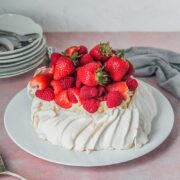
Pavlova
With humble origins in Australasia, this Pavlova recipe is a perfect make ahead dessert. Sometimes seen as a fiddly dessert, you will require patience with the oven to get a perfect crust on the exterior and marshmallow interior before you can top with whipped cream and any seasonal fruit.
Servings 10
Calories 176kcal
Ingredients
Pavlova
- 114 grams / 3 large or 5 small egg whites room temperature
- 200 grams / 1 cup superfine/caster sugar
- 30 grams / 2 tablespoons boiling water
- 5 grams / 1 teaspoon vinegar
- 1 teaspoon vanilla extract
Topping
- 227 grams / 1 cup heavy cream
- 20 grams / 1 tablespoon lemon curd
- 225 grams / 1 cup raspberries roughly broken
- 225 grams / 1 cup strawberries roughly chopped
Instructions
Pavlova
- Preheat the oven to 140ºC/280F and line a baking tray with greaseproof paper.
- Place the sugar, boiling water, vinegar, vanilla extract and egg whites in a clean bowl and beat on medium until the meringue is stiff and holds its shape when you pull the beater away, approximately 12 minutes with a hand beater.
- Spoon the meringue onto your greased tray and shape carefully into whichever pavlova shape you prefer with an offset spatula or the back of a spoon.
- Place in the oven and bake for 30 minutes before turning the temperature down to 120ºC/265F and bake for a further 30 minutes.
- Turn the oven off and allow to cool completely, minimum 2 hours before removing.
- Remove and place onto your serving plate.
Topping
- Whip the cream until soft peaks just form than fold in the lemon curd. Spread over the top of the pavlova and place your berries on top.
- Serve immediately.
Notes
- Egg whites: Room temperature fresh egg whites are best for a great pavlova as they are less likely to collapse.
- Sugar: Superfine or caster sugar will dissolve easily in our meringue and add sweetness without additional flavor. You could replace with white sugar. It is not recommended to substitute with brown sugar due to the flavor it will add to the pavlova.
- Vinegar: Vinegar strengthens the egg white structure helping stabilize and ensure the there is no seepage.
- Boiling water: The boiling water helps raise the temperature in the egg white mixture which makes this meringue closest to a Swiss Meringue helping make our meringue denser in texture than a French meringue and less fussy than an Italian meringue.
- Only use room temperature egg whites: They absorb air more quickly to develop a nice and stable foam - though to really stabilize that foam we’ll need an acidic element (the vinegar we use here).
- Shaping your Pavlova: Simply stenciling the shape you want for your pavlova onto the underside of your baking paper will help give you an easy border to work with. And the back of a spoon or offset spatula will help you create your desired shape.
- Try not to overbeat your meringue: Over whipping egg whites can result in your meringue collapsing or weeping beads of sugar once baked. The best way to avoid over beating is to ensure you beat at a steady speed and allow at least 20-30 seconds of beating time for the sugar to dissolve between adding more. Try not to beat for longer than 15 minutes (this is around the break point, I’ve noticed). Unfortunately, you cannot repair over whipped meringue, though, dependent on how over whipped they are, you could make an egg white based recipe such as macaroon’s or even a baked Alaska.
Nutrition
Calories: 176kcal